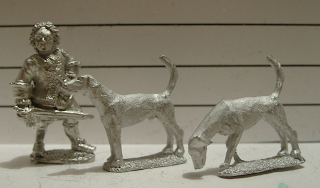 |
| "A three month wait for miscasts madam?" |
Your author has been buying wargames items for over a quarter century and I am sad to say that I feel the general level of service is deteriorating. I am tired of poor service from manufacturers and wonder if others are also.
With your average 28mm figure now priced well above the psychological £1.00 barrier, we are paying more than ever before to get our hands upon little lead men. When paying such a premium I for one expect a good standard of service and also a product that is quality checked before dispatch.
Actually, I believe whatever price you pay the item should be in fit condition and supplied as advertised.
Yes of course delays will occur and miscasts will slip through - everyone makes a mistake now and then. However I cannot help but feel that a great many vendors are just sloppy or simply hope their mistakes won't be noticed by the buyer. Alternatively, perhaps they bank upon customers' reticence to complain - this is something from which I do not suffer!
Actually, I believe whatever price you pay the item should be in fit condition and supplied as advertised.
Yes of course delays will occur and miscasts will slip through - everyone makes a mistake now and then. However I cannot help but feel that a great many vendors are just sloppy or simply hope their mistakes won't be noticed by the buyer. Alternatively, perhaps they bank upon customers' reticence to complain - this is something from which I do not suffer!
It is not my intention to "name and shame" anyone in particular but in the last six months I have been fed a great many cock-a-mamey excuses, including:
- "I am a one-man-band. That is why I billed your credit card three weeks ago and have not even got around to filling your order" - very popular.
- "Sid/Jim/Bob (delete as applicable) went on holiday the week after we got your order and we have to wait for him to come back."
- "Miscasts? Well yeah, there are a few but most customers never complain."
- "Our moulds are old and the metal doesn't flow too well."
- "Yes he is missing his nose/hand/cockade but you could rebuild it with putty/it wouldn't be noticeable in a unit."
- "Why are you complaining about miscasts? Our figures are cheaper than so and so's."
Some of these have come from companies I had once rated as having excellent customer service. I find this very disappointing.
I am aware that wargamers are a tolerant bunch but such statements gall. There is no reason why the consumer should accept such shoddiness when buying any product. The fact that these are little toy soldiers does not alter things! If you think about it, would you be so tolerant if a sandwich seller said:
"You got a pubic hair in your chicken salad? Well, I am a one-man-band and my other customers never complain. Pull it out of the mayo, it won't change the taste of the sandwich."
In short, a vendor should excersize a little elementary customer service:
- If there are unexpected delays, drop the customer an email. Most people will understand that real life can intrude.
- Going on holiday and anticipate a delay when the order is accepted? Then he/she should alert the buyer to the situation and check that you are happy to proceed.
- When a defective item slips through, there should be an apology with an immediate offer to exchange the item and refund the return postage (if required).
- Moulds getting worn? Then remake them! Don't rely on people not noticing or being scared to complain!
Now perhaps the postman will today deliver those two orders for which I am still waiting after 3 weeks...










































